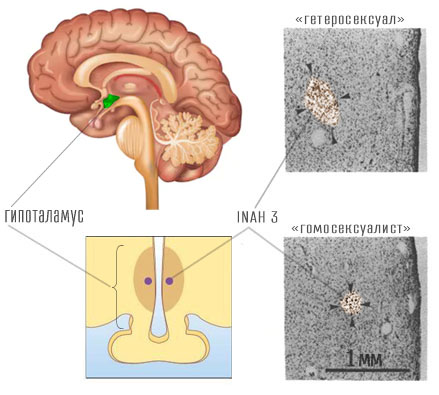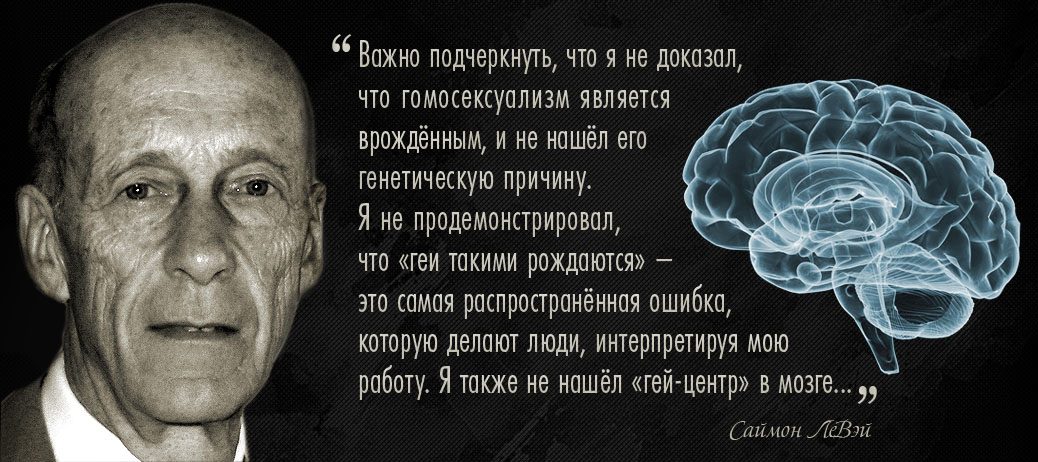As confirmation of the “innateness” of homosexual attraction, LGBT activists often refer to research neuroscientist Simon LeVay from 1991, in which he allegedly discovered that the hypothalamus of “homosexual” men is the same size as that of women, which supposedly makes them homosexuals. What did LeVay actually discover? What he did not find definitively was a connection between brain structure and sexual proclivities.
LeVay conducted his research on the results of autopsies. He divided the subjects into three groups - 6 “heterosexual” women, 19 “homosexual” men who died of AIDS, and 16 “heterosexual” men (these parameters are given in quotation marks, since the sexual preferences of the deceased were largely speculative). In each group, LeVay measured the size of a special region of the brain known as third intermediate nucleus of the anterior hypothalamus (INAH-3). Several such nuclei are distinguished in the hypothalamus. size from 0.05 to 0.3 mm³, which are numbered: 1, 2, 3, 4. Normally, the size of INAH-3 depends on the level of the male hormone testosterone in the body: the more testosterone, the larger the INAH-3. LeVay stated that INAH-3 sizes in homosexual men were significantly smaller than in heterosexual men, and closer to the typical female size. And although the sample included “homosexuals” with the maximum INAH-3 sizes and “heterosexuals” with the minimum, according to LeVay, the data obtained indicate that “sexual orientation has a biological basis.”

There were many methodological flaws in LeVay's study, which he himself had to repeatedly state, but the media kept silent about them. Firstly, it is the problematic nature of the selection of objects of research: LeVey did not know what sexual inclinations most of the people he studied had during their lifetime. He classified them as "heterosexual" or "predominantly heterosexual" on the basis of the numerical superiority of heterosexual men in the population.
Secondly, it is well known that in patients with AIDS in the terminal stage low levels of testosterone are observed, both due to the influence of the disease and due to side effects of treatment. From LeVay’s data, it’s completely impossible to determine how large the INAH-3 was at birth and to exclude the fact that it could decrease during life. LeVey himself makes the reservation in the same article:
"... the results do not allow us to conclude whether the size of INAH-3 is a cause or effect of an individual's sexual orientation, or whether the size of INAH-3 and sexual orientation mutually change under the influence of some third unidentified variable" (LeVay 1991, p. 1036).
Thirdly, there is no reason to say with certainty that LeVey discovered anything at all. Researchers Ruth Hubbard and Elijah Wald questioned not only the interpretation of LeVay's results, but the very fact that any significant differences were found. Although LeVey pointed out that the average size of INAH-3 is smaller in the group of prospective homosexuals than in the group of prospective heterosexuals, it follows from his results that the maximum and minimum variation in values is exactly the same in both groups. According to the law of normal distribution, the largest number of trait owners has the parameters of this very trait in the middle range, and only a small number of owners have parameters of extreme value.
According to the rules of statistical calculations, to identify a statistically significant difference between two groups of subjects, you cannot compare a parameter that does not have a normal distribution. In LeVay's study, INAH-3 was reduced in size in most “homosexual” men and some “heterosexual” men, and normal in size in most “heterosexual” men and some “homosexuals.” It follows that it is completely impossible to conclude anything about the relationship between the size of the hypothalamus and sexual behavior. Even if any differences in brain structure were convincingly demonstrated, their significance would be on par with the discovery that the muscles of athletes are larger than those of ordinary people. What conclusions can we draw based on this fact? Does a person develop larger muscles by playing sports, or does an innate predisposition to larger muscles make a person an athlete?
And fourthly, LeVey said nothing about the relationship of sexual behavior and INAH-3 in women.
It should be noted that LeVey, who did not hide his homosexual addictions, was fully committed to discovering the biological basis of homosexuality. According to him: “I felt that if I didn’t find anything, I would completely abandon science” (Newsweek xnumx, p. 49). Nevertheless, in an 1994 interview, LeVey admitted:
“… It is important to emphasize that I have not proven that homosexuality is innate or found a genetic cause. I have not demonstrated that gay people are "born this way" - this is the most common mistake they make. peopleinterpreting my work. I also did not find a "gay center" in the brain ... We do not know if the differences I discovered were present at birth or appeared later. My work does not address the question of whether sexual orientation was established before birth ... "(Nimmons xnumx).
Any specialist in the field of neuroscience knows such a phenomenon as neuroplasticity - the ability of nervous tissue to change its function and structure during a person’s life under the influence of various factors, both damaging (injuries, substance use), and behavioral (Kolb 1998). Brain structures, for example, change from of pregnancystay in space and kind Occupation individual.
In 2000 year group of scientists published the results of a brain test in London taxi drivers. It turned out that for taxi drivers, the brain area responsible for spatial coordination was much larger than for individuals from the control group who did not work as taxi drivers. In addition, the size of this section directly depended on the number of years spent working in a taxi. If the researchers pursued political goals, they could have stated something like: “These taxi drivers need to be issued with the right-hand drive and wherever they work, it’s worth changing the left-hand drive to the right-hand drive - because they were born that way!”
To date, a convincing evidence base has been accumulated in favor of the plasticity of both brain tissues in general and the hypothalamus in particular (Bains xnumx; Sale 2014; Mainardi 2013; Hatton xnumx; Theodosis 1993), therefore, in confirmation of the words spoken by LeVey himself in the 1994 year, the contribution of his research to the hypothesis of the innate nature of homosexuality is zero.
RESPONSIBILITY OF LEVEY'S RESEARCH
Nobody managed to repeat LeVey's results. In the publication of 2001 of the year, research team from New York conducted a similar study, comparing the same areas of the hypothalamus as in the LeVay study, but with much more complete data and an adequate distribution of the subjects. No correlation of the size of INAH-3 with homosexuality was found. The authors concluded that:
“… Sexual orientation cannot be reliably predicted based on the volume of INAH-3….” (Byne xnumx, p. 91).
In any case, the discovery of a statistical relationship between the studied variables does not at all imply a causal relationship between them. Even if the results of LeVey's research were confirmed, they would only indicate the presence of neuropathology. If a man’s liver instead of 1,6 kg weighs 1,2 kg, like a woman’s liver, then a certain pathology can be concluded with certainty. The same applies to any other organ of atypical size, including the nucleus of the hypothalamus.

LOL Byne's research did support LeVay's. He just used a two tailed model which makes the association weaker. Nice quote mining, liar.
here: https://pro-lgbt.ru/5670/
And Here: https://pro-lgbt.ru/285/
More written about this includes differences in brains homosexuals and heterosexuals and about “innateness this phenomenon”
Lo dicho, no hay ninguna evidencia científica que marce una diferencia biológica entre personas ambiguamente “homosexuales” (como si eso se pudiera definir cuantitativamente) o con una atracción por personas del mismo sexo. El asunto es psicológico. Además la intención de marcar una fisiología diferente, seria reducir una conducta a una enfermedad que debería tratarse con “alargamiento del hipotálamo”. Y esa atracción seria equiparable al cáncer, diabetes, o enfermedades congénitas. Las cuales no pueden justificar una condición “humana” diferente. Es muy interesante las falacias que se construyen por grupos de presión, sesgos ideológicos y que posteriormente son magnificados por los medios masivos, los cuales no son médicos.
Hmm) But what about other studies that show differences in the brain as well as their activity?)
There is not a single study that proves that homosexuals and heterosexuals have the same brains and their reactions.
All of the research on brain differences says that it has not been possible to prove whether these differences are innate or not. The brain is plastic, it can change under the influence of propaganda.